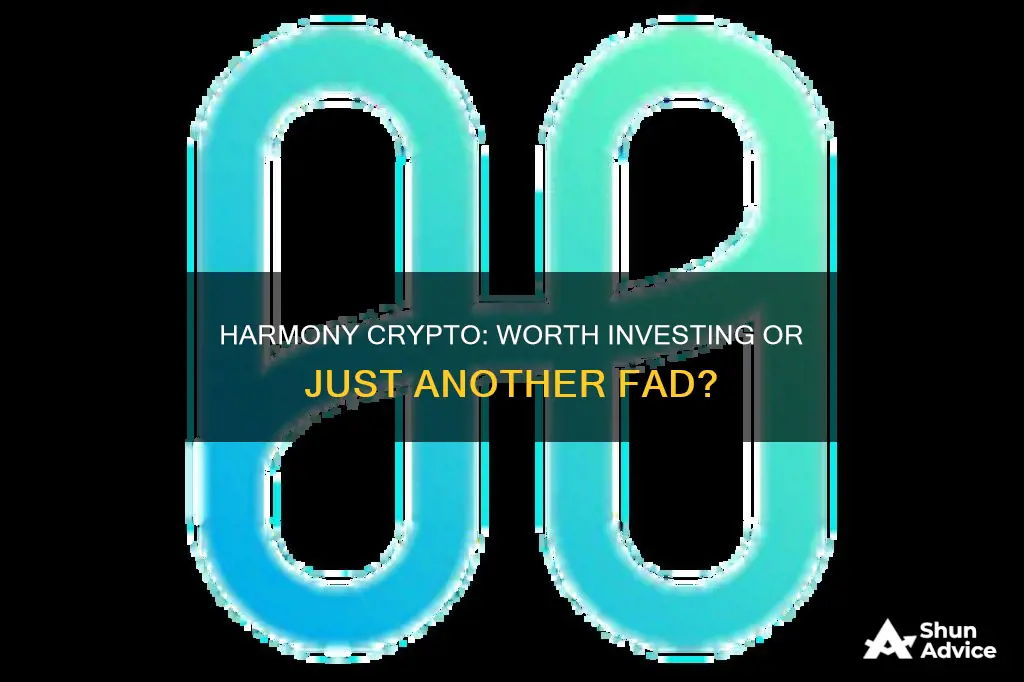
Harmony (ONE) is a blockchain platform that facilitates the creation and use of decentralized applications (DApps). It was founded in 2017 by Stephen Tse, a former senior engineer at Google and principal engineer at Apple. ONE is designed to be a secure and efficient protocol in the cryptocurrency space, with a focus on achieving both decentralization and scalability through its innovative sharding technology. Sharding allows validators to approve transactions and new blocks simultaneously, increasing processing speed and reducing validation times.
With its unique features and growing popularity among developers and investors, is ONE crypto a good investment?
| Characteristics | Values |
|---|---|
| Purpose | Scalability, speed, and being cheap relative to Ethereum |
| Max finality | 2 seconds, often 1 second |
| Sharding | Splitting a blockchain into separate shards that run simultaneously to speed up the blockchain and reduce congestion |
| Effective proof of stake | Modifying rewards and adding downtime penalties and bans against bad validators |
| Cross-chain capabilities | Share data across multiple blockchain networks |
| NFT potential | Lower gas fees make the network more appealing for creators who want to mint NFTs |
| Horizon bridge | Allows users to go back and forth easily between Ethereum, Binance Smart Chain, and NFTs |
| Token | Used for crypto staking, voting, etc. To stake, you need at least 100 tokens, and to validate, you need at least 10,000 tokens |
| Supply and demand dynamics | The coin is inflationary due to the average transaction burning about 0.000021 One coins |
| Price history | The price of ONE was just under $0.13 in early March 2022 and reached an all-time high of $0.38 in October 2021 |
What You'll Learn

Harmony's blockchain infrastructure
The Harmony blockchain network is a fast and secure blockchain for decentralized applications. It is a Layer 2 blockchain that aims to be a secure and efficient protocol in the cryptocurrency space.
Harmony's network layer is based on the industry-leading p2p protocol named libp2p. It uses libp2p's gossip protocol for network message broadcasting and stream protocol for decentralized state synchronization. To achieve high performance, RaptorQ fountain code and the Adaptive Information Dispersal Algorithm are used to quickly and efficiently broadcast large blocks.
Harmony also features a design where Kademlia routing is used to achieve cross-shard transactions that scale logarithmically with the number of shards. This allows for asynchronous cross-shard transactions, which achieve eventual consistency so no double-spending is possible between shards.
The network's consensus algorithm is called Fast Byzantine Fault Tolerance (FBFT). FBFT is a highly efficient and speedy consensus algorithm built upon the Practical Byzantine Fault Tolerance (PBFT) algorithm, which is the cornerstone for distributed systems and consensus research. FBFT is highly optimized in network message processing and block proposal pipelining, allowing the consensus to scale to hundreds of validators simultaneously.
Dogecoin Investment: Worthwhile or Risky Venture?
You may want to see also

Sharding and scalability
Sharding is a process that improves scalability by distributing a single dataset across several databases, which can be stored on multiple machines. In the context of Harmony's blockchain network, sharding is used to divide validators into multiple groups, allowing them to approve transactions and new blocks simultaneously. This process is known as random state sharding, and it enables the network to process a high volume of transactions while maintaining security and decentralization.
Harmony's sharding process involves splitting the network into four shards. Validators are randomly assigned to each shard and are moved to new shards after each Epoch to prevent hostile attacks. Each shard has a limited number of validator slots, known as BLS Keys, to ensure scalability and meet future network demand increases.
One of the key benefits of Harmony's sharding is its ability to process a high volume of transactions per second (TPS). Currently, Harmony can handle 2,000 TPS, comparable to Visa's payment processing capacity. In the long run, Harmony believes it could achieve a processing capacity of 10 million TPS. This makes Harmony's blockchain network highly scalable and efficient, addressing the challenges faced by other blockchain networks in maintaining security and decentralization while scaling.
The use of sharding also contributes to Harmony's low gas fees. Unlike other networks with high gas fees, such as Ethereum, Harmony's network rarely gets clogged due to its high TPS and efficient proof-of-stake validation. Even in cases of extremely high demand, Harmony can solve congestion issues by adding more shards, ensuring smooth and cost-effective transactions.
In summary, Harmony's implementation of sharding plays a crucial role in its ability to scale while maintaining decentralization and security. By dividing the network into shards and utilizing random state sharding, Harmony achieves high transaction processing speeds, low gas fees, and efficient network operations. This makes Harmony a promising solution for improving scalability and interoperability in the blockchain and cryptocurrency space.
Vanguard's Crypto Investment Plans: What You Need to Know
You may want to see also

Proof-of-stake consensus
The Harmony blockchain network uses a proof-of-stake consensus mechanism, which relies on a distributed cohort of stakeholders, known as validators, to validate transactions and generate new coins. Under this mechanism, validators don't use computing power to validate transactions and generate new coins. Instead, they deposit or stake their own money on the network. This is in contrast to the proof-of-work system used by Bitcoin, where energy-intensive miners use their computing power to verify each new block of transactions in exchange for new coins.
The proof-of-stake consensus mechanism used by Harmony has several benefits. Firstly, it helps to address the ""blockchain trilemma" of balancing scalability with security and decentralization. By using sharding, Harmony can process 2,000 transactions per second, with each transaction taking an average of 2 seconds to settle. This is much faster than Ethereum, which takes around 10 minutes to settle a transaction. Secondly, the proof-of-stake mechanism helps to reduce fees. Fees on the Harmony network are 1,000 times lower than on the Ethereum network. Thirdly, the proof-of-stake mechanism helps to improve security. Harmony's proof-of-stake consensus mechanism and architecture enable the network to finalize blocks in just two seconds, preventing the network from becoming congested.
Harmony's proof-of-stake consensus mechanism also has some unique features. One of these is the use of random assignment of validators to shards. This helps to prevent coordinated attempts to take over the network and keep validators in line. Another feature is the use of fines and rewards to discourage the hoarding of tokens. This helps to maintain decentralization and improve transaction speeds.
Overall, the proof-of-stake consensus mechanism used by Harmony helps to address the challenges of scalability, security, and decentralization faced by blockchain networks. It also helps to reduce fees and improve transaction speeds, making it a more efficient and user-friendly network.
Legitimate Bitcoin Investment: A Secure Guide to Crypto
You may want to see also

Cross-chain capabilities
In late November, Harmony launched a bridge called Horizon, which facilitates cross-chain interoperability with Ethereum, allowing for the transfer of assets between the two networks. This feature has significant implications for cross-border payments and the ease of exchanging cryptocurrencies. Harmony has also established bridges with other chains, including Binance.
The ability to share data across multiple blockchain networks is a powerful tool for NFT creators, as it lowers gas fees and makes the network more appealing for those who want to mint NFTs. Additionally, Harmony's cross-chain capabilities open up interesting possibilities for non-fungible tokens (NFTs), enabling the secure transfer of digital art, video, and audio files on a blockchain network.
The combination of cross-chain capabilities and low gas fees makes Harmony a compelling tool for NFT creators and enhances the network's overall functionality and interoperability. This positions Harmony as a strong competitor in the blockchain space, offering seamless interoperability and efficient transaction processing.
S-Corp Bitcoin Investment: What's the Verdict?
You may want to see also

NFT potential
The potential of the ONE cryptocurrency token is heavily tied to its NFT capabilities.
Harmony's cross-chain capabilities open up interesting possibilities for non-fungible tokens (NFTs). With lower gas fees, the network may be more appealing to creators who want to mint NFTs. While bridging NFTs from one network to another may initially be expensive, subsequent transactions will be cheaper.
Harmony's proof-of-stake validation means the network rarely gets clogged like Ethereum, so it does not suffer from high gas fees. This is appealing to NFT creators, who may be put off by the high transaction costs of other networks.
The network's ability to process 2,000 transactions per second (TPS) is comparable to Visa, one of the largest payment rails in the world. Long-term, Harmony thinks it could get up to processing 10 million TPS. This massive scalability, coupled with decentralization and security, will enable the blockchain to accomplish feats that weren't realistic on other blockchain networks, such as setting up large decentralized exchanges, large payment rails, and "internet-of-things transactions".
The ONE token is an inflationary token, which means that assets with limited and diminishing supplies are often held onto, whereas assets that increase in supply over time see higher numbers of transactions. This could be an advantage for NFT creators, who want their work to be widely traded.
Overall, ONE has the potential to be a good investment, especially for those with a high-risk tolerance. Its NFT capabilities are a key part of this potential, with its low gas fees, scalability, and security making it an appealing prospect for NFT creators.
Why Ripple Could Be a Better Investment Than Bitcoin
You may want to see also
Frequently asked questions
Harmony is a blockchain platform that aims to improve the way decentralised applications work by focusing on random state sharding, which allows the creation of blocks in seconds.
Harmony uses a distributed randomness generation process to assign nodes that connect to the network and validate transactions to different shards. It also maintains a low threshold of ONE tokens that nodes need to have to join the network as validators.
In early March 2022, the price of ONE was just under $0.13, and its all-time high was $0.38 in October 2021. As of June 2024, the price of ONE is about $0.23, representing an increase of more than 5,200% over the last year.
Harmony ONE offers ample investment opportunities because protocols that can implement seamless and secure interoperability will see massive public adoption. Its use of sharding and low gas fees also makes it a great tool for NFT creators.
ONE faces stiff competition from other Layer 2 blockchains, including Cardano, Avalanche, and Solana. The market volatility and competition can be a strong deterrent for potential investors.







